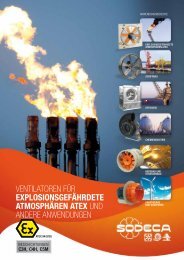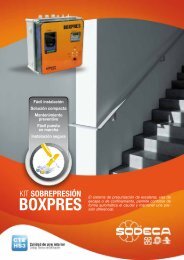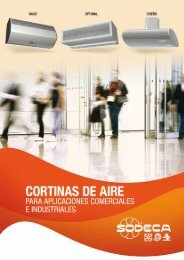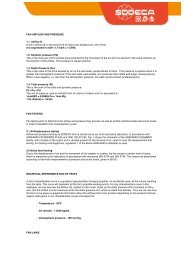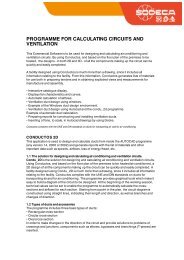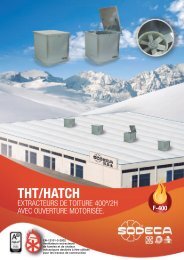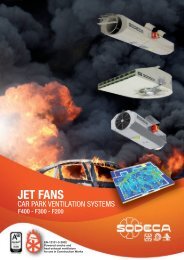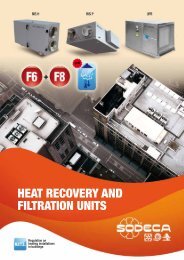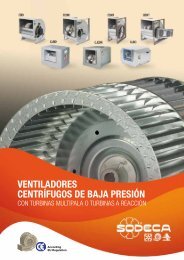ErP - Sodeca
ErP - Sodeca
ErP - Sodeca
You also want an ePaper? Increase the reach of your titles
YUMPU automatically turns print PDFs into web optimized ePapers that Google loves.
<strong>ErP</strong> DIRECTIVE<br />
MORE ECO-EFFICIENT FANS<br />
What does the new “ERP”<br />
directive mean<br />
The <strong>ErP</strong> Ecodesign directive 2009/2015/<br />
CE is going to encourage sustainable<br />
and economic use of the available energy<br />
resources. Its main goals are encouraging<br />
ecological design and fighting against<br />
climate change by reducing CO2<br />
emissions to the atmosphere.<br />
In coming years, applying this directive will<br />
affect all energy receptor and consumer<br />
products in a way that is respectful to the<br />
environment.<br />
• In effect until the year 2020, the EU<br />
is attempting to comply with the<br />
KYOTO treaty by increasing the use of<br />
renewable energies by 20% rather than<br />
those coming from minerals.<br />
• This can be achieved by controlling<br />
and improving the quality of the<br />
performance of electronic devices with<br />
more efficient new designs.<br />
For this reason, specific norms are<br />
being developed for each co-marketed<br />
product in the EU: Electric motors, water<br />
pumps, fans for residential and industrial<br />
environments, transformers, etc... And<br />
for this goal, a series of studies is being<br />
carried out for the different categories<br />
of apparatuses ranked by LOT, from<br />
which the first regulations are appearing,<br />
including those for fans.<br />
How is the <strong>ErP</strong> directive going<br />
to affect fans<br />
The first regulation from the (EU)<br />
Committee 327/2011 has already been<br />
published, as a fruit of the study for<br />
the “LOT 11” category, which is going<br />
to regulate non-residential fans with<br />
absorbed electric power between 125W<br />
and 500 KW.<br />
The regulation establishes two phases for<br />
its complete implementation:<br />
• 1st phase: Starting in January 2013,<br />
the first level of requiring efficiency in<br />
fans will be applied.<br />
• 2nd phase: Starting in January 2015 is<br />
when these levels of requirements will<br />
be increased.<br />
These two phases are related with those<br />
already applied by the 2009/640/EC<br />
Directive on standard electric motors,<br />
which began last year in June 2011. Since<br />
then, <strong>Sodeca</strong> has been applying IE2<br />
efficient motors in all of its fans.<br />
In the second phase after January 2015,<br />
all electric motors used must comply with<br />
an IE3 efficiency. IE2+ Inverter motors<br />
and EC motors will be utilize as the only<br />
alternatives.<br />
The efficiency of fans will be greatly<br />
improved through the use of more<br />
efficient motors. Improvements will also<br />
be introduced through the use of more<br />
appropriate configurations of turbine<br />
propellers or through new, more optimal<br />
designs.<br />
After each phase, products not complying<br />
with the aforesaid requirement will not<br />
be able to be marketed in the European<br />
market.<br />
Are there exceptions on the<br />
affected fans<br />
Yes, at least with the corresponding fans<br />
included in the LOT11 category, and<br />
apart from products that are regulated<br />
in the future by other categories that<br />
have not yet been finalized. The current<br />
(EU) 327/2011 regulation in effect<br />
corresponding to LOT11 contains<br />
exceptions, such as:<br />
• Fans for ATEX explosive atmospheres.<br />
• Fans exclusively for emergency use<br />
(400ºC/2h, 300ºC/1h, etc...)<br />
• Fans specifically for working in<br />
environments greater than 65ºC, or to<br />
bring gases to more than 100ºC.<br />
• Fans specifically for working in<br />
environments or temperatures of gases<br />
brought lower than -40ºC.<br />
• Fans with motors of special voltages<br />
Vac>1000V or Vcc>1500V.<br />
• Fans for toxic, highly corrosive or<br />
inflammable environments.<br />
• Fans used to transport non-gaseous<br />
(solid) substances, in industrial<br />
processes.<br />
There is also the possibility of marketing<br />
fans that do not comply with 327/2011,<br />
until January 1, 2015, if they are destined to<br />
replace fans integrated in products marketed<br />
before January 1, 2013.<br />
2
And with products exported to other countries outside the EU<br />
Compliance with this directive will only be required within the EU.<br />
Will the efficient fans be specially marked<br />
Yes, CE labels will be prohibited on products that fail to comply with this directive. It should also be well specified which products<br />
comply, both in the catalogs and selection programs that are utilize.<br />
Will these fans be more expensive<br />
Many <strong>Sodeca</strong> fans already comply with the requirements of the directive. But in cases where acquisition is significantly higher, the<br />
energy savings will make up for the investment. And as a result, they will be much more profitable over the long term. <strong>Sodeca</strong> is<br />
incorporating new, state of the art technologies with IE2, IE3 and EC system high efficiency motors, which will also provide other<br />
advantages of regulation, communication and interaction with other equipment.<br />
SOLUTIONS THAT SODECA OFFERS AS ALTERNATIVES<br />
THAT ARE DETERMINED BY EACH CASE:<br />
Directly using three-phase, synchronized<br />
IE2 and IE3 motors. Solution especially<br />
indicated for power greater than 1 CV<br />
(750W).<br />
The same IE2 synchronized motors<br />
combined with marketed frequency<br />
regulators in the installation of the<br />
equipment, or through compact systems<br />
with the electronics already included in the<br />
motor or fan and assembled in the factory.<br />
This combination will facilitate adapting<br />
to 50Hz or 60Hz networks, with different<br />
voltages and including single-phase<br />
networks if the equipment’s power allows<br />
for it.<br />
Or also through BRUSHLESS, permanent<br />
magnet EC motors Motors that permit<br />
obtaining very high efficiencies with speed<br />
and constant pairing independent from the<br />
charge. In comparison with normal induction<br />
motors, they can achieve equivalent<br />
powers but with much greater efficiency<br />
and reduced size. In this case, electronics<br />
are incorporated and therefore control and<br />
regulation functions will be incorporated.<br />
3
How is the goal of efficiency calculated<br />
The CE Regulation nº 327/2011 has assigned minimum<br />
requirements of efficiency in two phases, the first is applicable<br />
in 2013 and the second, which is more strict, in 2015. The goals<br />
of efficiency are determined according to the type of fan, the<br />
electric power consumed in the point of maximum efficiency of<br />
the fan and the type of aerodynamic test used. The degree of<br />
efficiency (N) is the value that the required efficiency provides for<br />
incoming electric power of 10 kW. N is different according to the<br />
type of test used and increases when passing from the first to the<br />
second phase of application. For example, in axial fans tested<br />
with C tests, the N value required for 2013 is 36% and for 2015 is<br />
40%, as shown in the following image.<br />
Goal (%) Goal for axial fans and measurements C-type<br />
42%<br />
Degree of<br />
efficiency 2015,<br />
N=40<br />
Degree of<br />
efficiency 2013,<br />
N=36<br />
40%<br />
38%<br />
36%<br />
34%<br />
32%<br />
30%<br />
28%<br />
26%<br />
24%<br />
22%<br />
2015<br />
2013<br />
0 2 4 6 8 10 12 14 16<br />
P e(d)<br />
(kW)<br />
IF THE FAN IS COMPLETELY SUPPLIED<br />
a. If it does not have<br />
a speed driver:<br />
b. If it does have<br />
a speed driver:<br />
Where, for the optimum point of efficiency:<br />
• η e<br />
is the global efficiency.<br />
• P u(s)<br />
is the gas power of the fan.<br />
• P e<br />
is the incoming electric power for the motor supply.<br />
• P ed<br />
is the incoming electric power for the speed driver supply.<br />
• C C<br />
is the compensation factor of the partial charge.<br />
For P ed<br />
greater than 5 kW, it is 1.04. For powers less than 5 kW,<br />
the factor is greater. See the image attached.<br />
C c<br />
1,16<br />
1,14<br />
1,12<br />
How is the efficiency of the fan calculated<br />
Fan performance is calculated at the point of maximum efficiency.<br />
This should be equal to or greater than the required goal. The<br />
calculation method is different according to the elements that the<br />
fan incorporates and whether or not it is in its final assembly.<br />
Electric<br />
power<br />
P ed<br />
Hydraulic<br />
power<br />
P us<br />
1,1<br />
1,08<br />
1,06<br />
1,04<br />
1,02<br />
0 0,75 1,5 2,25 3 3,75 4,5 5,25 6<br />
P ed<br />
(kW)<br />
Losses<br />
Driver<br />
Losses<br />
Motor<br />
Losses<br />
Transmission<br />
Losses<br />
Turbine<br />
4
IF THE FAN IS SUPPLIED IN PIECES<br />
0,9<br />
0,85<br />
0,8<br />
0,75<br />
0,7<br />
Where, for the optimum point of efficiency:<br />
0,65<br />
0,6<br />
0,55<br />
• η e<br />
is the global efficiency.<br />
• η r<br />
is the turbine efficiency, according to<br />
Where P u(s)<br />
is the gas power and P a<br />
is the mechanical power<br />
to the axis of the turbine.<br />
• η m<br />
is the motor efficiency. Motors should be used that comply<br />
with the (CE) Regulation nº 640/2009 for motor efficiency.<br />
If the fan is supplied without a motor or the motor is not covered<br />
by the regulation of motors, the performance can be estimated<br />
according to the incoming electric power recommended (P e<br />
(kW))<br />
for the optimum point of energy efficiency of the fan. These<br />
values by default can be observed in the following image.<br />
• η T<br />
is the efficiency of the transmission system. For fans with<br />
direct transmission, it is equal to 1. The transmission is<br />
considered highly efficient when the belt width is equal to or<br />
greater than triple its height. Timing belts and toothed gears are<br />
also highly efficient. Its performance can be estimated through<br />
the power at the turbine axis (Pa (kW)). Pa values are considered<br />
constant that are less than 1 kW and greater than 5 kW. See the<br />
image attached.<br />
• C m<br />
is the compensation factor to take into account to adapt to<br />
the components. It is 0.9.<br />
• C C<br />
is the compensation factor of the partial charge. If there is no<br />
speed regulator, it is 1. If there is a driver, it has the same values<br />
as the fan in final assembly.<br />
0,5<br />
0 1 2 3 4 5<br />
P e<br />
(kW)<br />
0,96<br />
0,94<br />
0,92<br />
0,9<br />
0,88<br />
0,86<br />
5 30 55 80 105 130 155<br />
P e<br />
(kW)<br />
Low efficiency<br />
High efficiency<br />
1<br />
0,98<br />
0,96<br />
0,94<br />
0,92<br />
0,9<br />
0,88<br />
0 1 2 3 4 5 6<br />
P a<br />
(kW)<br />
5
EFFICIENT WORK<br />
SV/EW<br />
In-line ducts fans, equipped<br />
with high efficiency,<br />
BRUSHLESS-EC motors<br />
controlled electronically.<br />
NEOLINEO/EW<br />
In-line fans for ducts<br />
of reduced size with<br />
electronically controlled<br />
motors DC-BRUSHLESS-<br />
EC, for extremely low<br />
consumption.<br />
HEP/EW<br />
Wall-mounted axial fans<br />
with a plastic propeller,<br />
equipped with BRUSHLESS<br />
INDUSTRIAL-EC motors<br />
and integrated electronics,<br />
with the possibility of being<br />
regulated by a 10K Ω, power<br />
meter, or a 0-10v signal.<br />
HC/EW<br />
Wall-mounted axial fans<br />
with a plastic propeller,<br />
equipped with IE-2 or IE-3<br />
motors, depending on the<br />
model, ready to work with<br />
inverters.<br />
HCH/EW<br />
Robust wall -mounted axial<br />
fans, with a plastic propeller,<br />
PL version or aluminum<br />
propeller, AL version,<br />
equipped with IE-2 or IE-3<br />
motors, depending on the<br />
model, ready to work with<br />
inverters.<br />
HCT/EW<br />
Robust long-cased axial<br />
fans, with a plastic propeller,<br />
PL version or aluminum<br />
propeller, AL version,<br />
equipped with IE-2 or IE-3<br />
motors, depending on the<br />
model, ready to work with<br />
inverters.<br />
CBD/EW<br />
Centrifugal double-inlet fans<br />
with:<br />
• BRUSHLESS-EC motor<br />
and integrated electronics,<br />
with the possibility of<br />
being regulated by a<br />
10K Ω, power meter, or a<br />
0-10v signal.<br />
• IE-2 motor with electronics<br />
in an auxiliary box<br />
CMP-S/EW<br />
Centrifugal mediumpressure<br />
small fans,<br />
equipped with a<br />
INDUSTRIAL BRUSHLESS<br />
motor and integrated<br />
electronics, with the<br />
possibility of being regulated<br />
by a 10K Ω, power meter, or<br />
a 0-10v signal.<br />
6
CMP-B/EW<br />
Centrifugal medium-pressure<br />
fans, equipped with an IE-2<br />
or IE-3 motor, depending<br />
on the model, ready to work<br />
with an inverter.<br />
CMR/EW<br />
Robust centrifugal<br />
single-inlet, mediumpressure<br />
fans equipped with<br />
backward-curved impeller,<br />
with an IE-2 or IE-3 motor,<br />
depending on the model,<br />
ready to work with inverters.<br />
CAS/EW<br />
Robust centrifugal<br />
single-inlet, high-pressure<br />
fans, equipped with<br />
backward-curved impeller,<br />
with an IE-2 or IE-3 motor,<br />
depending on the model,<br />
ready to work with an<br />
inverter.<br />
HT-S/EW<br />
Roof fans with a plastic<br />
fibreglass, equipped with<br />
BRUSHLESS INDUSTRIAL-<br />
EC motors and integrated<br />
electronics, with the<br />
possibility of being regulated<br />
by 10K Ω power meter, or a<br />
0-10v signal.<br />
HT-B/EW<br />
Roof fans with a plastic<br />
fibreglass, equipped with<br />
an IE-2 or IE-3 motor,<br />
depending on the model,<br />
ready to work with an<br />
inverter.<br />
CHT/EW<br />
400ºc/2h centrifugal roof<br />
fans with horizontal outlet<br />
air, and equipped with IE-2<br />
or IE-3 motors, depending<br />
on the model, ready to work<br />
with inverters.<br />
CVT/EW<br />
400ºc/2h centrifugal roof<br />
fans with vertical outlet air<br />
and equipped with an<br />
IE-2 or IE-3 motor,<br />
depending on the model,<br />
ready to work with an<br />
inverter.<br />
CHRE/EW<br />
Low noise centrifugal roof<br />
fans with a high efficiency,<br />
electronically controlled<br />
BRUSHLESS-EC motor.<br />
7
AXIAL FANS<br />
AND ROOF FANS<br />
CENTRIFUGAL FANS<br />
AND IN-LINE DUCT FANS<br />
FANS FOR THE<br />
SMOKE EXTRACTION<br />
FANS FOR ATEX EXPLOSIVE<br />
ATMOSPHERES AND OTHER<br />
APPLICATIONS<br />
NEW SERIES - NEW PRODUCTS<br />
NEW CATALOGUES<br />
NEW BUSINESS OPPORTUNITIES<br />
LOW-PRESSURE<br />
CENTRIFUGAL FANS<br />
HEAT RECOVERY AND<br />
FILTRATION UNITS<br />
AIR CURTAINS FOR<br />
COMMERCIAL AND<br />
INDUSTRIAL APPLICATIONS<br />
VENTILATION SYSTEMS<br />
FOR HOUSES AND FLATS<br />
Request<br />
Information<br />
Crta. de Berga, km 0.7<br />
E-08580 St. Quirze de Besora<br />
BARCELONA (Spain)<br />
Tel. +34 93 852 91 11<br />
Fax.+34 93 852 90 42<br />
comercial@sodeca.com<br />
Export sales: ventilation@sodeca.com<br />
www.sodeca.com



